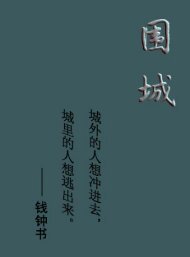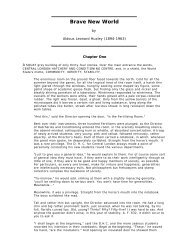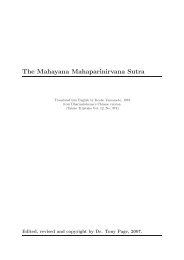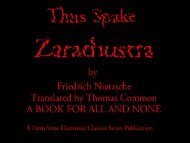Aphoristic Writings, Notebook, and Letters to a Friend, by Otto ...
Aphoristic Writings, Notebook, and Letters to a Friend, by Otto ...
Aphoristic Writings, Notebook, and Letters to a Friend, by Otto ...
Create successful ePaper yourself
Turn your PDF publications into a flip-book with our unique Google optimized e-Paper software.
That Goethe had a high opinion of Schiller naturally proves nothing, because he<br />
also had a very high opinion of Wiel<strong>and</strong>, Byron <strong>and</strong> several painters of his time, <strong>and</strong><br />
there wasn’t much <strong>to</strong> them either.<br />
Hercules is Doric. Doric <strong>and</strong> Ionic must be sharply separated in Hellenism. They<br />
are related <strong>to</strong> each other as poverty <strong>to</strong> wealth, as simplicity <strong>to</strong> opulence.<br />
*<br />
*<br />
The most pious work of art that I know is the “Farnese Hercules” (in the Naples<br />
Museum). It is more pious than the Hercules saga itself, with an endlessly captivating<br />
impression. The “Farnese Bull” appears beside it as an expression of talent.<br />
*<br />
That people can speak of Raphaelesque trash next <strong>to</strong> Michelangelo, I underst<strong>and</strong>;<br />
they will probably always do this, because Raphael is <strong>to</strong> be unders<strong>to</strong>od completely<br />
without genius, <strong>and</strong> Michelangelo only through it. The one makes every consideration<br />
for the beholder, the other, none whatsoever. Raphael becomes <strong>to</strong>tally impotent when<br />
he seeks <strong>to</strong> portray God, Christ or philosophy. He aids himself <strong>by</strong> dispensing with the<br />
essence from the outset; people then declare that work original <strong>and</strong> praise it as a<br />
counterclaim <strong>to</strong> Michelangelo. Raphael never dared <strong>to</strong> allow a subject <strong>to</strong> be shown<br />
entirely from the back, least of all God himself (which Michelangelo has done in the<br />
Second Fresco of the Sistine).<br />
In order <strong>to</strong> know who Michelangelo, <strong>and</strong> what Raphael is, one can compare a<br />
painting of lesser significance <strong>by</strong> the former, the “Deluge”, with one of the most<br />
outst<strong>and</strong>ing of the latter, “Fire in the Borgo”. These are very well suited in<br />
homologous content <strong>and</strong> because, in Michelangelo, no depictions of the masses are<br />
otherwise present.<br />
Raphael paints a group here, another there, piece <strong>by</strong> piece, each occupied with<br />
something different; the unity is <strong>to</strong>tally lost. Michelangelo immediately grasps the<br />
essence of the matter: he paints the deluge, the event itself in its most elemental force,<br />
<strong>and</strong> thence gives himself <strong>to</strong> all else, all retroaction upon the people, who precisely<br />
here must exclude any individuation.<br />
*<br />
55







